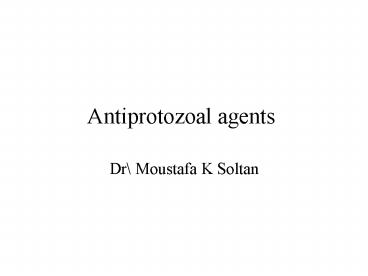Antiprotozoal agents - PowerPoint PPT Presentation
1 / 16
Title:
Antiprotozoal agents
Description:
Antiprotozoal agents Dr\ Moustafa K Soltan Antiprotozoal agents Dr\ Moustafa K Soltan Classification of Antiprotozoal agents. antiparastic antiprotozoal ... – PowerPoint PPT presentation
Number of Views:1531
Avg rating:3.0/5.0
Title: Antiprotozoal agents
1
Antiprotozoal agents
- Dr\ Moustafa K Soltan
2
Classification of Antiprotozoal
agents. antiparastic
antiprotozoal anthelmintics
unicellular parasites multicellular
parasites . Protzoal infections may be one
or more infection results from the following 1)
amoebiasis. 2)
trichomoniasis. 3) girdiasis. 4)
leishmaniasis. 5)
trypanosomiasis. 6) malaria. 7)
toxoplasmosis.
Classification of antiprotozoal infections I
Antiamoebic drugs. For treatment of Entamoeba
histolytica infections. Tissue amoebicides
(hepatic amoebiasis ) Extraintestinal amoebicides
Act in extraintestinal tissues, in liver, bowel
wall they include nitroimmidazole.
metronidazole, tinidazole , secnidazole.
chloroquine antimalarial emetine,
dehydroemetine antibiotic amoebicides
paromomycin
3
luminal amoebicides intestinal amoebicides. act
in bowel lumen (intestine) they
include halogenated 8-hydroxy quinoline
Chiniofon, clioquinol, iodoquinol.
dichloroacetamide derivatives diloxanide
furoate organoarsenicals carbarsone. II
Antitrichomonal and antigiardial agents are some
antiamoebic agents. III Antileishmanial drugs
1) antimonial drugs sodium stipogluconate.
2)
diamidines pentamidine isothionate. IV
Antitrypanosomal drugs (trypanocides) 1)
5-nitrofuran derivatives nifurtimox
2) urea derivatives suramin sodium. V
antimalarial drugs.
4
- Nitroimmidazole. metronidazole
- 2-methyl-5-nitro-1-(2-hydroxyethyl) immidazole..
- Or
- 2-(2-methyl-5-nitro-1-immidazolyl) ethanol.
- Tinidazole
- 2-methyl-5-nitro-1-2-(2-ethylsulfonyl) ethyl
immidazole. - Secnidazole
- 2-methyl-5-nitro-1-(2-hydroxypropyl)- immidazole.
(or) - 1-(2-methyl-5-nitro-1-immidazolyl)-2-hydroxypropan
e.
5
selectivity of nitro group containing
antibacterial, antiamoebic, antitrypanosomal
arises from absence of nitroreudctase in human
and presence of it in the invading organism. 2)
so we can say that in metronidazole, tinidazole,
secnidazole, nitro group cause both the activity
and selectivity. 3) advantages of tinidazole and
secnidazole over metronidazole 1)
less incidence of side effects. 2) administered
single dose daily for 4 days due to high T1/2,
while metronidazole 7-10 days. Mechanism of
action. Reduction of nitro group by
nitroreductase enzyme to unstable, cytotoxic
intermediate, interact with DNA prevent further
replication so death. so we can say nitro group
is essential for activity. Uses. 1) Intestinal
and extraintestinal antiamoebic. 2)antitrichomonal
,antigiardial,antileishmanial 3)anaerobic
bacteria cause septicemia.tinidazole has fewer
side effects than metronidazole.
6
2) halogenated 8-hydroxy quinoline Chiniofon
Sodium salt of 7-iodo-8-hydroxuquinoline-5-sulfo
nate
Iodoquinol 5,7-diiodo-8-hydroxyquinoline
7
Skraup synthesis of quinoline ring begin from it
when asked in synthesis of halogenated 8-hydroxy
quinoline derivatives ( chiniofon, iodoquinol
begin from oxine) ( clioquinol begin from
5-chlorooxine)
role of conc. H2SO4 Converting glycerol into
acrolien which react with o-aminophenol. We can
not use acrolein directly as it is toxic
compound. role of nitrobenzene oxidation of
1,2-dihydroquinoline to quinoline ring and
reduced to aniline. role of ferrous sulfate
preventing explosion of the reaction.
8
Clioquinol 5-chloro-7-iodo-8-hydroxyquinoline
3) dichloroacetamide derivatives Diloxanide
furoate 4-(2,2-dichloro-N-methylacetamido)phenyl-
2-furoate
9
Mechanism of action Chelating properties of
8-hydroxyquinoline which bind ferrous atom inside
cell Uses 1)intestinal amoebiasis but cause
neurotoxicity. 2) antibacterial, antifungal
activity so in skin diseases like dermatitis,
eczema, psoriasis (Clioquinol) Uses of
Diloxanide intestinal amoebiasis, drug of choice
in case of asymptomatic amoebiasis (carriers)
10
4) organoarsenicals Carbarsone
4-ureido-1-phenyl arsonic acid or 4-carbamoyl
amino phenyl arsonic acid or N-carbamoyl
arsanilic acid. Or p-uriedobenzene arsonic
acid.
As5 is reduced to As3 which interact with
thiol Group of enzymes present in the parasite
through complexation reaction leading to death.
It acts on trophozite phase of Entamoeba. Used
in intestinal amoebiasis.
11
Assay
12
Antileishmanial drugs. Sodium Stipogluconate Ant
imony sodium Gluconate.
13
Pentamidine Isothionate. 4,4-
-(pentamethylenedioxy) dibenzamidino-bis-
(2-hydroxyethanesulfonate).
14
Sod stipgluconate Sb5 is reduced to Sb3 which
inhibit phosphofructokinase enzyme in parasite
Drug of choice in treatment of
leishmania Pentamidine isothionate 1) interact
with DNA resulting in inhibition of DNA, RNA and
protein synthesis.2)interfere with polyamine
uptake due to structure similarity. 1)alternative
for visceral leishmaniasis. 2)2ry agent in
treatment, prophylaxis against African
trypanosomiasis.
15
Antitrypanosomal.
Nifurtimox 4-(5-nitrofufurylidene)amino-3-methy
lthiomorpholine-1,1-dioxidex
Suramin sodium Hexasodium carbonyl-bis-8-3-(3-
aminobenzamido)-4-methylbenzamido
Naphthalene-1,3,5-trisulfonate
16
Uses South American trypanosomiasis which is
called ( chagas disease) caused by
Trypanosome cruzi (in early stage)
Suramin sodium Inhibit various trypanosomal
enzymes such as Glycerol-3-phosphate oxidase, so
block glycolysis in parasite which depend on
glycolysis for energy production so death. Drug
of choice in the prophylaxis against African
trypanosomiasis in early stages































